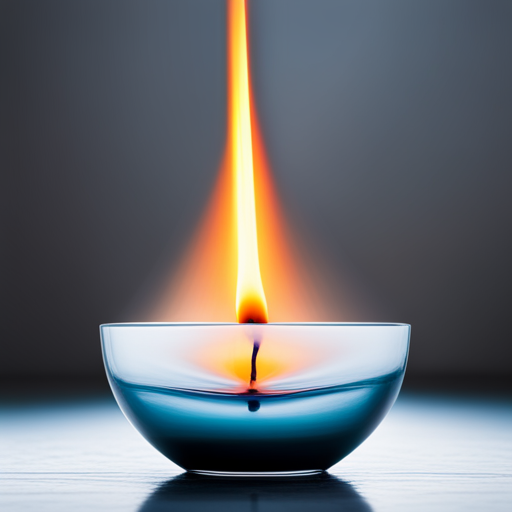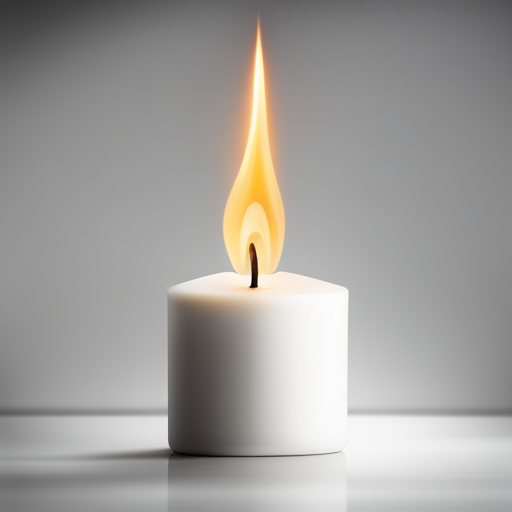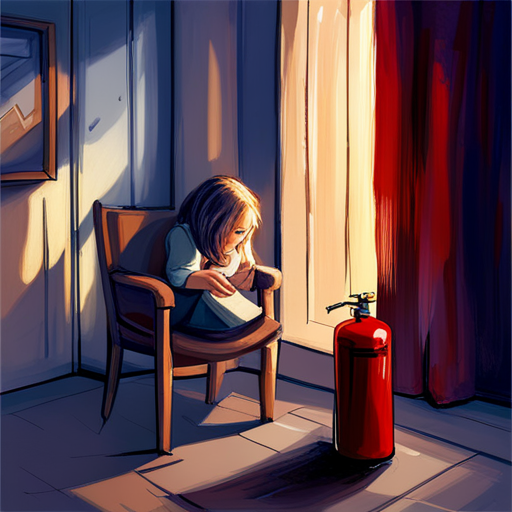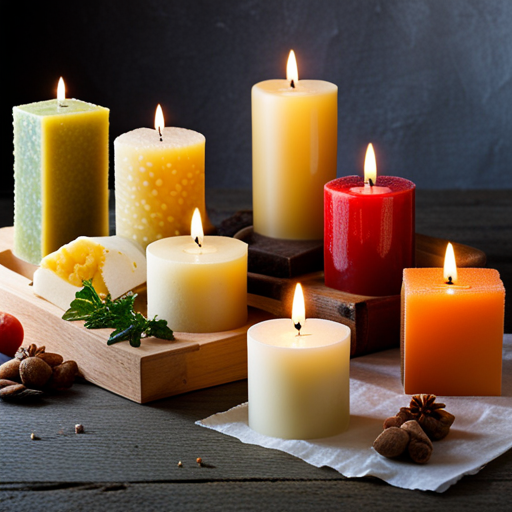Different types of wax have different ignition temperatures. When a candle is lit, the wax melts and releases fumes that can contain carbon monoxide. Therefore, it is crucial to exercise caution and never leave a burning candle unattended.
This article will explore the flammability of candle wax in detail to answer the question, ‘Is candle wax flammable?’
Key Takeaways
– Candle wax requires only a small amount of heat to ignite, making it highly flammable.
– The composition and quality of the wax, as well as any additives, can affect its flammability.
– The presence of a wick in the candle plays a crucial role in its ability to catch fire.
– Proper safety measures should be taken when using candles to prevent fire hazards, such as keeping them away from flammable materials and never leaving them unattended.
Factors Affecting Candle Wax Flammability

https://www.youtube.com/watch?v=HiIpQGtI0KI
The composition, quality, and presence of additives can all impact the flammability of candle wax.
The type of wax used in candles plays a significant role in determining its flammability. For example, paraffin wax, which is commonly used in candles, has a lower ignition temperature compared to beeswax. Soy wax, on the other hand, generally has a lower ignition temperature than paraffin wax.
Additionally, additives such as fragrance oils or colorants can increase the flammability of candle wax. The size and shape of the candle can also affect its flammability, as well as the presence of a wick.
It is important to consider these factors when using candles to ensure proper safety precautions are taken.
Ignition Temperature of Candle Wax

Ignition temperatures of different types of candle wax can vary depending on their composition, additives, and quality. Here are four key factors that influence the ignition temperature of candle wax:
1. Composition: Different types of wax, such as paraffin, beeswax, soy, and coconut wax, have varying ignition temperatures. For example, paraffin wax commonly used in candles has an ignition temperature ranging from 370 to 420 degrees Celsius.
2. Additives: The presence of additives, such as fragrance oils or colorants, can affect the ignition temperature of candle wax. Some additives may lower the ignition temperature, increasing the flammability of the wax.
3. Quality: The quality of the wax can impact its ignition temperature. Higher quality waxes may have higher ignition temperatures, making them less prone to accidental ignition.
4. External factors: Environmental conditions, such as drafts or proximity to flammable materials, can influence the ignition temperature of candle wax. It is important to consider these factors when using candles to ensure safety.
Behavior of Wax When Burning

When lit, the melted wax from a burning candle drips out of the wick and solidifies again at the bottom of the container. This behavior of wax when burning is a natural part of the candle’s combustion process. As the heat from the flame melts the wax, it becomes a liquid and travels up the wick, where it is vaporized and burned. The melted wax then falls back down to the bottom of the container, where it cools and solidifies once again. This cycle continues as long as the candle is burning. The process of wax melting and solidifying is what allows the candle to continue burning and releasing its fragrance. It is important to ensure that the container is stable and heat-resistant to prevent any accidents or spills.
| Behavior of Wax When Burning |
|---|
| Wax melts when exposed to heat |
| Melted wax travels up the wick |
| Wax vaporizes and burns at the flame |
| Melted wax falls back down to the bottom of the container |
| Wax solidifies again as it cools |
Fire Hazard and Safety Measures

Burning candles should always be placed away from flammable materials and kept out of reach of children and pets. To ensure safety, here are four important measures to consider:
1. Proper storage: Candles should be stored in a safe location where they cannot be knocked over or exposed to heat sources. This prevents accidental tipping or fire.
2. Supervision: It’s crucial to never leave a burning candle unattended, especially when children or pets are present. This helps to avoid any potential fire hazards.
3. Extinguishing methods: In the event of a wax fire, it’s important to act quickly. Douse the flames with water, cover them with sand or dirt, or place wet towels over the fire. Different types of candles may require specific extinguishing methods, so proper knowledge is necessary.
4. Candle placement: Always keep candles away from anything that could potentially ignite or cause an explosion. This includes flammable materials such as curtains or paper. Additionally, use heat-resistant and stable candle holders to prevent accidents.
Alternative Candle Wax Options

Beeswax, soy wax, coconut wax, palm wax, and vegetable-based waxes are all eco-friendly alternatives to traditional candle waxes. These alternative waxes are gaining popularity in the candle industry due to their sustainable and renewable nature. They offer a more environmentally conscious choice for candle makers and consumers alike.
| Wax Type | Source | Benefits |
| Beeswax | Bees | Natural, non-toxic, emits a subtle honey-like scent, long burn time |
| Soy Wax | Soybeans | Renewable, biodegradable, clean-burning, supports farmers |
| Coconut Wax | Coconuts | Sustainable, clean-burning, long burn time, retains fragrance well |
| Palm Wax | Palm Trees | Renewable, biodegradable, unique crystalline appearance, long burn time |
| Vegetable-based waxes | Rapeseed or Sunflower oil | Renewable, biodegradable, clean-burning, low soot emission |
These alternative waxes not only offer a greener option, but they also provide various benefits such as longer burn times, cleaner-burning properties, and the ability to retain fragrance well. By choosing these eco-friendly alternatives, individuals can enjoy the soothing ambiance of candles while minimizing their impact on the environment.
Conclusion: Is Candle Wax Flammable?

Using alternative candle waxes can provide a safer option for individuals concerned about the flammability of traditional candle wax. These alternative waxes have different compositions and properties that make them less prone to catching fire. Here are four benefits of using alternative candle waxes:
1. Lower flammability: Alternative waxes like beeswax, soy wax, coconut wax, and palm wax have higher ignition temperatures compared to traditional paraffin wax. This means they are less likely to catch fire easily.
2. Reduced toxic smoke: Traditional candle waxes can release harmful gases and soot when burned. Alternative waxes, on the other hand, produce cleaner and healthier smoke, making them a better choice for indoor use.
3. Renewable and eco-friendly: Many alternative waxes, such as soy wax and coconut wax, are derived from renewable resources, making them more sustainable options for candle making.
4. Unique characteristics: Each alternative wax has its own unique characteristics, such as the crystalline appearance of palm wax or the natural scent of beeswax. These qualities can enhance the overall candle experience for users.
Can Candle Wax Catch Fire if the Glass Explodes?
Yes, preventing candle glass explosions is crucial. If a glass candle holder explodes, the wax could catch fire if it comes into contact with an open flame or hot surface. It’s important to use appropriate candle holders and extinguish candles properly to minimize the risk of accidents.
Frequently Asked Questions
Can Candle Wax Spontaneously Ignite Without a Heat Source?
Candle wax cannot spontaneously ignite without a heat source. It requires a small amount of heat, such as an open flame from matches or lighters, to ignite.
Does the Color of Candle Wax Affect Its Flammability?
The color of candle wax does not affect its flammability. Flammability depends on the composition, quality, and additives in the wax, as well as external factors like drafts or proximity to flammable materials.
How Does the Size of a Candle Affect Its Flammability?
The size of a candle can impact its flammability. Larger candles have more surface area for the flame to ignite, increasing the risk of a fire. Smaller candles are generally less flammable.
Can the Quality of Candle Wax Impact Its Ignition Temperature?
The quality of candle wax can impact its ignition temperature. Factors such as composition, additives, and wax type determine the flammability. Higher quality wax may have a higher ignition temperature, while additives can affect the wax’s ability to catch fire.
Are There Any Safety Precautions Specific to Beeswax Candles?
Safety precautions specific to beeswax candles include allowing them to cool completely before removing the lid for extinguishing, and keeping them away from flammable materials. Always trim the wick and never leave them unattended.
